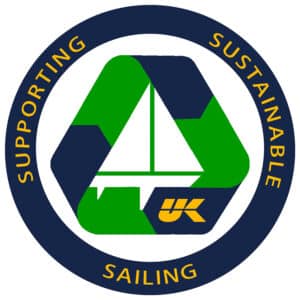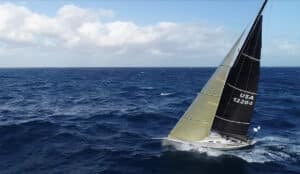UK Sailmakers realizes that, regardless of how deep your pockets are, sails are an investment, so here are some tips for how to avoid roller furling failures. The sun is perhaps your sails’ biggest enemy as UV rays will breakdown sailcloth as well as the stitching and webbing used to finish your sails. That’s why we recommend you have proper sail coverings for your sails. For mainsails left on the boom, using a traditional sail cover or Lazy Cradle® (Photo 1) will greatly extend the life of your sail. For roller furling headsails, a properly installed UV protective layer on the leech and foot of the sail will serve the same purpose.
Importantly, the materials UK and other sailmakers use for UV protective coverings don’t last forever. Depending on the length of your sailing season and how far north or south you are, the peak performance life of your UV coverings will vary. Pro Tip: if your cover or UV leech protective covering is faded and worn, chances are that its protective capabilities have been compromised. Have your UK sailmaker inspect your UV coverings and, if necessary, replace them.
UV covers are only effective when properly installed and used. Just having UV protection on a jib’s leech doesn’t guarantee your sail will be protected from the sun’s harmful rays. For example, Photo 2 shows a properly installed genoa UV cover that’s not rolled up all the way. There are parts of the sail unnecessarily exposed to the sun. Photo 3 shows the proper way to roller furl a sail with all the parts covered. Pro Tip: Notice that there are three wraps of the sheets around the sail to keep the sail from being blown open.
Some times we see UV damge on sails where the sail has been roller furled backwards. This normally happens when the UV cover is the same color as the sail. To avoid mistakes, UK Sailmakers applies warning labels to let you know if the UV cover is properly deployed. Photo 4 shows some examples of our warning labels.
Some sailmakers save money by sewing the braids and the cover all at once to save time. What happens is the stitching gets weakened by the sun’s UV rays and after a while, the ring will pull off the sail. See Photo 5. At UK Sailmakers, we sew down the UV cover after the sail has been completed so that it covers every part of the sail except for the outside edge of the rings. Photo 6.
How will you know when your UV protective coverings need to be replaced? Recognizing that nothing lasts forever, your cover may look fine other than looking a little faded and stained; however, the UV cover material is only effective for 5-10 years, depending on how close your boat is to the tropics and how many days a year you leave the rolled up genoa up. The first sign that your cover is getting old is when the stitching holding it to the sail starts to breakdown. Most times you can have the cover re-stitched, but by the time the re-stitching breaks down, the cover will have to be replaced. Photo 7 shows a jib on the loft floor that has been destroyed by the sun because UV cover outlived its useful life. You may also see small vertical tears in the material under the UV cover before the sail fails catastrophically. In fact, if you bring your sail to your local UK Sailmakers loft for annual service, we look for UV damage that indicates your cover needs replacement.
Protect your sails from harmful UV rays and sail with confidence.



